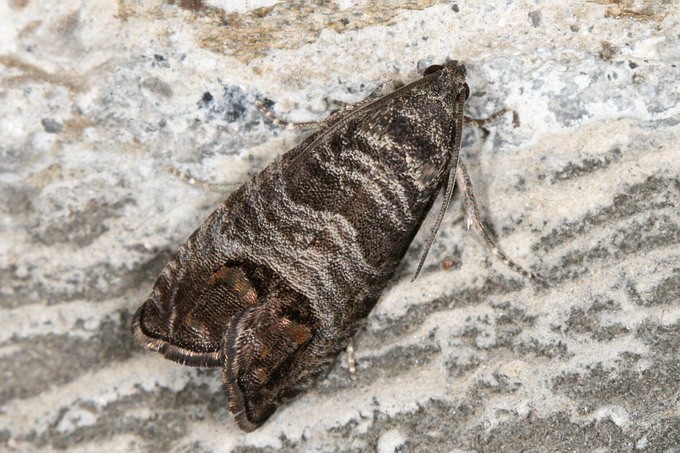Codling moth
(Cydia pomonella)

Description
The codling moth (Cydia pomonella) is a member of the Lepidopteran family Tortricidae. They are major pests to agricultural crops, mainly fruits such as apples and pears. Because the larvae are not able to feed on leaves, they are highly dependent on fruits as a food source and thus have a significant impact on crops. The caterpillars bore into fruit and stop it from growing, which leads to premature ripening. Various means of control, including chemical, biological, and preventive, have been implemented. This moth has a widespread distribution, being found on six continents. Adaptive behavior such as diapause and multiple generations per breeding season have allowed this moth to persist even during years of bad climatic conditions. Viability and fitness of the codling moths are highly dependent on humidity levels and climate. Under observation, the optimal conditions for moth growth and survival were 32 °C and 75% humidity. Even if the temperature is favorable, low and high levels of relative humidity (20% and 100% respectively) led to hindrance in pupation. At a temperature below 0 °C, the larvae become completely inactive and turn seemingly lifeless. However, researchers observed that if the temperature is returned to optimal levels, the larvae regained normal activity. Codling moths have been located at altitudes as high as 1000–1500 m. Because the codling moth is polyphagous, or able to utilize a variety of food sources, the availability of specific food resources does not determine their optimal habitat. Various stages of the moth's life history, from eggs to pupae, can be found on host plants which the larvae feed on. These plants include apple, pear, walnut, chestnut, and even apricot trees. Although the geographic origin of codling moths is unclear, there are theories of these moths originating from either Europe or the Mediterranean. Scholars believe that the codling moths were introduced to the Americas in the mid-1700s. There is still debate on whether or not these moths have been distributed by humans. Today, the codling moths are spread all over the world, ranging from Europe, Asia, Africa, North and South America, Australia, and islands in the Pacific. Codling moths are not large, as the full grown adult codling moth has an average length of 10 mm and wingspan of 20 mm. The wings fold into a tent-like shape when the moths are resting.
Taxonomic tree:







